Uber's Unfair Dismissal of Drivers and HRM Issues Analysis Report
VerifiedAdded on 2020/03/16
|10
|2040
|42
Report
AI Summary
This report examines the human resource management (HRM) issues at Uber, specifically focusing on the company's controversial practice of classifying drivers as independent contractors and the subsequent unfair dismissal of drivers, particularly in Australia. The report provides an executive summary and delves into the background of the story, highlighting the drivers' concerns about job security and the lack of employee benefits. It identifies the problem statement as the security issues of the employees, and analyzes the situation through the lens of Hofstede's cultural dimensions and Trompenaars' model of national cultural differences. The report explores how cultural differences, such as the collectivist orientation of many Uber drivers, particularly those of Indian and Bangladeshi descent, clash with the individualistic approach of the American-based company. It discusses the implications of these cultural differences on HRM practices. The report concludes by recommending that Uber needs to focus on workforce diversities and better understand cultural dimensions to ensure fair treatment of employees and provide a safer work environment. The report also notes how some national courts have ruled that Uber drivers should be considered employees and not self-employed, thus granting them the same rights as employees.
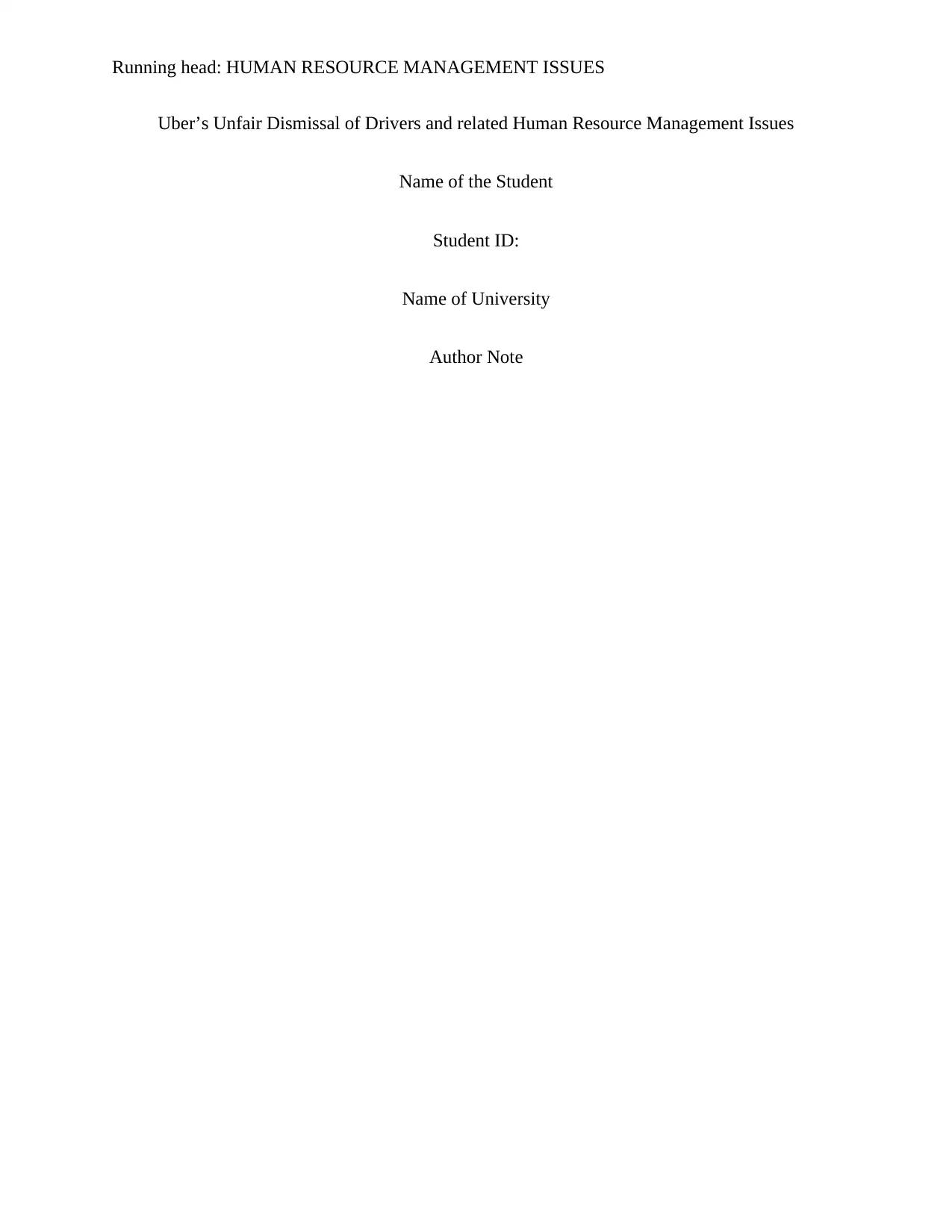
Running head: HUMAN RESOURCE MANAGEMENT ISSUES
Uber’s Unfair Dismissal of Drivers and related Human Resource Management Issues
Name of the Student
Student ID:
Name of University
Author Note
Uber’s Unfair Dismissal of Drivers and related Human Resource Management Issues
Name of the Student
Student ID:
Name of University
Author Note
Paraphrase This Document
Need a fresh take? Get an instant paraphrase of this document with our AI Paraphraser
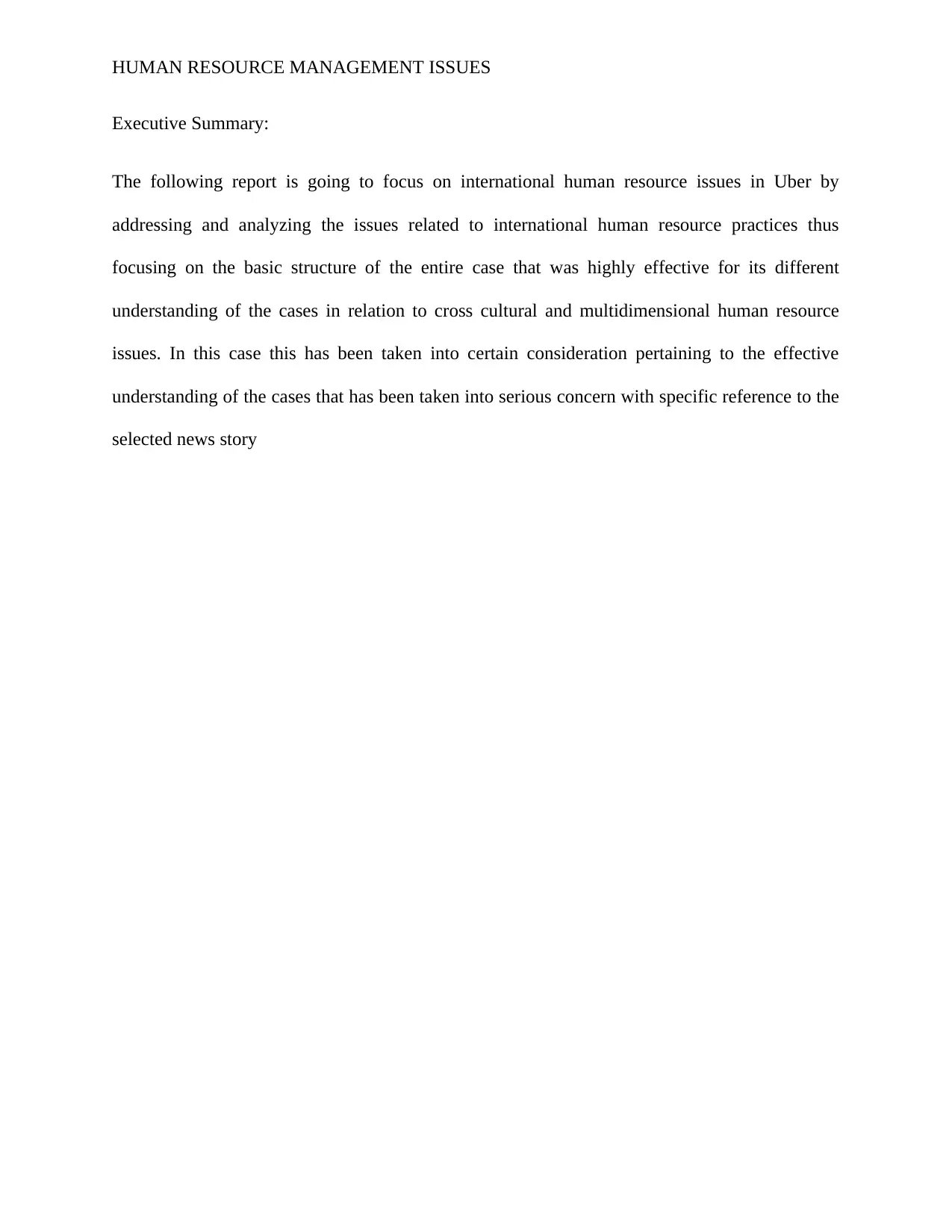
HUMAN RESOURCE MANAGEMENT ISSUES
Executive Summary:
The following report is going to focus on international human resource issues in Uber by
addressing and analyzing the issues related to international human resource practices thus
focusing on the basic structure of the entire case that was highly effective for its different
understanding of the cases in relation to cross cultural and multidimensional human resource
issues. In this case this has been taken into certain consideration pertaining to the effective
understanding of the cases that has been taken into serious concern with specific reference to the
selected news story
Executive Summary:
The following report is going to focus on international human resource issues in Uber by
addressing and analyzing the issues related to international human resource practices thus
focusing on the basic structure of the entire case that was highly effective for its different
understanding of the cases in relation to cross cultural and multidimensional human resource
issues. In this case this has been taken into certain consideration pertaining to the effective
understanding of the cases that has been taken into serious concern with specific reference to the
selected news story
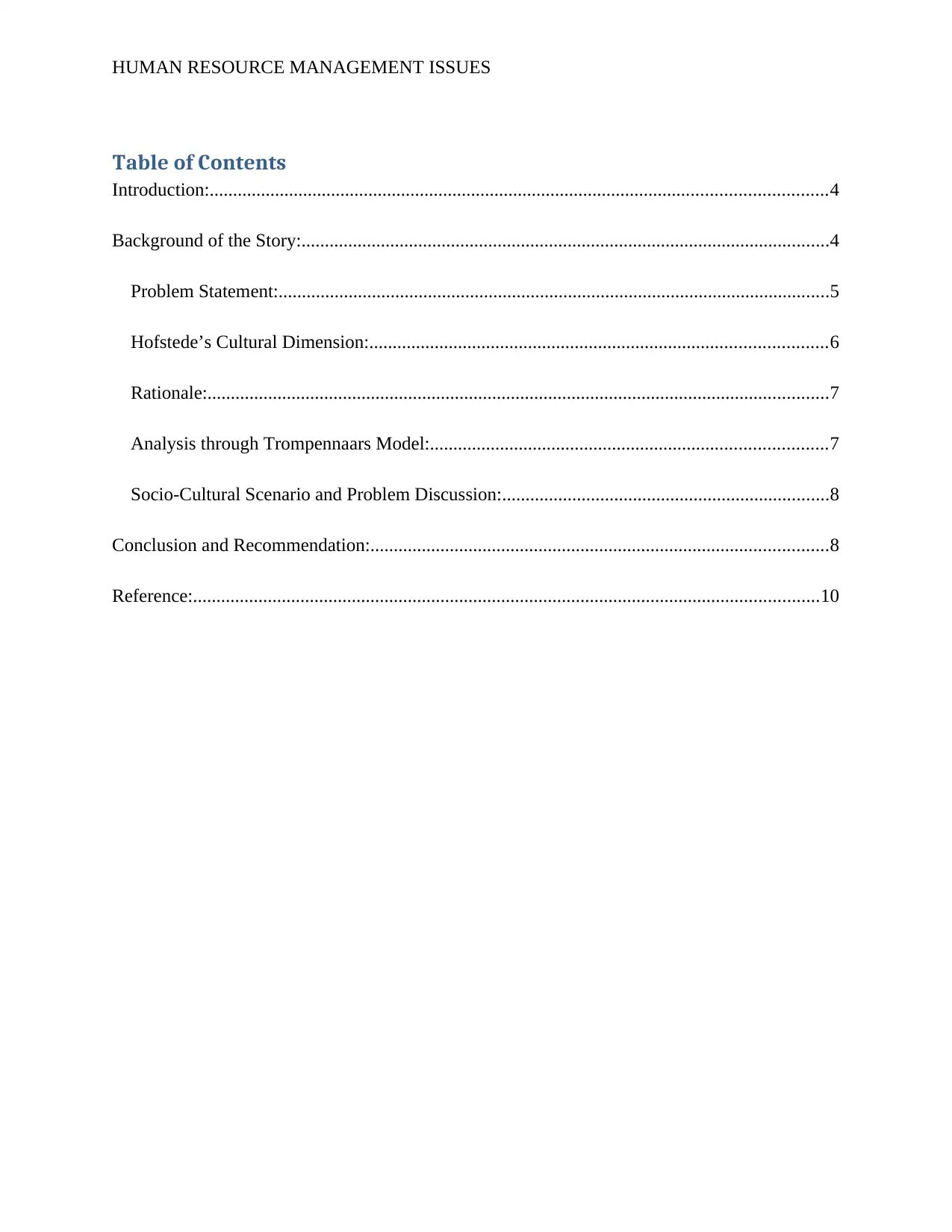
HUMAN RESOURCE MANAGEMENT ISSUES
Table of Contents
Introduction:....................................................................................................................................4
Background of the Story:.................................................................................................................4
Problem Statement:......................................................................................................................5
Hofstede’s Cultural Dimension:..................................................................................................6
Rationale:.....................................................................................................................................7
Analysis through Trompennaars Model:.....................................................................................7
Socio-Cultural Scenario and Problem Discussion:......................................................................8
Conclusion and Recommendation:..................................................................................................8
Reference:......................................................................................................................................10
Table of Contents
Introduction:....................................................................................................................................4
Background of the Story:.................................................................................................................4
Problem Statement:......................................................................................................................5
Hofstede’s Cultural Dimension:..................................................................................................6
Rationale:.....................................................................................................................................7
Analysis through Trompennaars Model:.....................................................................................7
Socio-Cultural Scenario and Problem Discussion:......................................................................8
Conclusion and Recommendation:..................................................................................................8
Reference:......................................................................................................................................10
⊘ This is a preview!⊘
Do you want full access?
Subscribe today to unlock all pages.

Trusted by 1+ million students worldwide
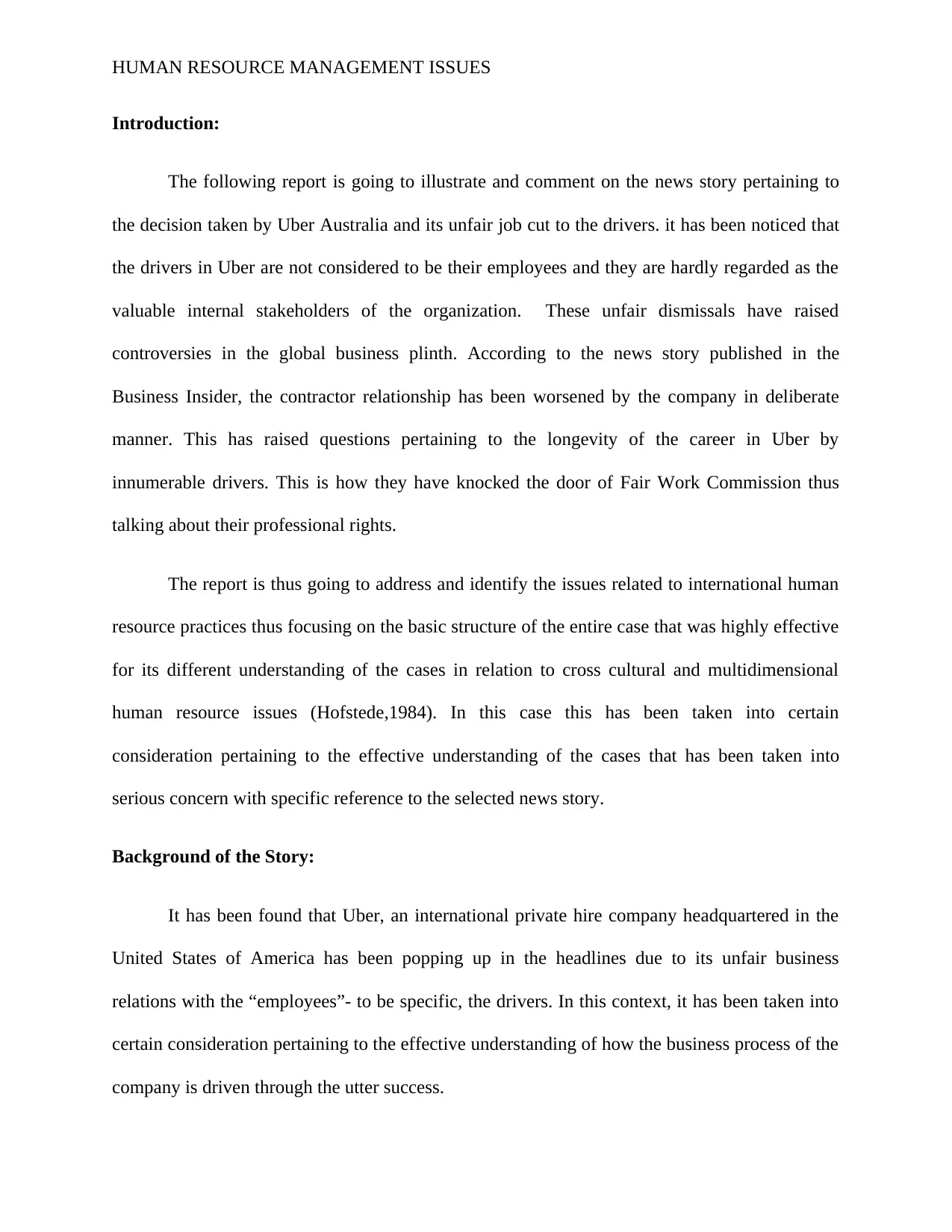
HUMAN RESOURCE MANAGEMENT ISSUES
Introduction:
The following report is going to illustrate and comment on the news story pertaining to
the decision taken by Uber Australia and its unfair job cut to the drivers. it has been noticed that
the drivers in Uber are not considered to be their employees and they are hardly regarded as the
valuable internal stakeholders of the organization. These unfair dismissals have raised
controversies in the global business plinth. According to the news story published in the
Business Insider, the contractor relationship has been worsened by the company in deliberate
manner. This has raised questions pertaining to the longevity of the career in Uber by
innumerable drivers. This is how they have knocked the door of Fair Work Commission thus
talking about their professional rights.
The report is thus going to address and identify the issues related to international human
resource practices thus focusing on the basic structure of the entire case that was highly effective
for its different understanding of the cases in relation to cross cultural and multidimensional
human resource issues (Hofstede,1984). In this case this has been taken into certain
consideration pertaining to the effective understanding of the cases that has been taken into
serious concern with specific reference to the selected news story.
Background of the Story:
It has been found that Uber, an international private hire company headquartered in the
United States of America has been popping up in the headlines due to its unfair business
relations with the “employees”- to be specific, the drivers. In this context, it has been taken into
certain consideration pertaining to the effective understanding of how the business process of the
company is driven through the utter success.
Introduction:
The following report is going to illustrate and comment on the news story pertaining to
the decision taken by Uber Australia and its unfair job cut to the drivers. it has been noticed that
the drivers in Uber are not considered to be their employees and they are hardly regarded as the
valuable internal stakeholders of the organization. These unfair dismissals have raised
controversies in the global business plinth. According to the news story published in the
Business Insider, the contractor relationship has been worsened by the company in deliberate
manner. This has raised questions pertaining to the longevity of the career in Uber by
innumerable drivers. This is how they have knocked the door of Fair Work Commission thus
talking about their professional rights.
The report is thus going to address and identify the issues related to international human
resource practices thus focusing on the basic structure of the entire case that was highly effective
for its different understanding of the cases in relation to cross cultural and multidimensional
human resource issues (Hofstede,1984). In this case this has been taken into certain
consideration pertaining to the effective understanding of the cases that has been taken into
serious concern with specific reference to the selected news story.
Background of the Story:
It has been found that Uber, an international private hire company headquartered in the
United States of America has been popping up in the headlines due to its unfair business
relations with the “employees”- to be specific, the drivers. In this context, it has been taken into
certain consideration pertaining to the effective understanding of how the business process of the
company is driven through the utter success.
Paraphrase This Document
Need a fresh take? Get an instant paraphrase of this document with our AI Paraphraser
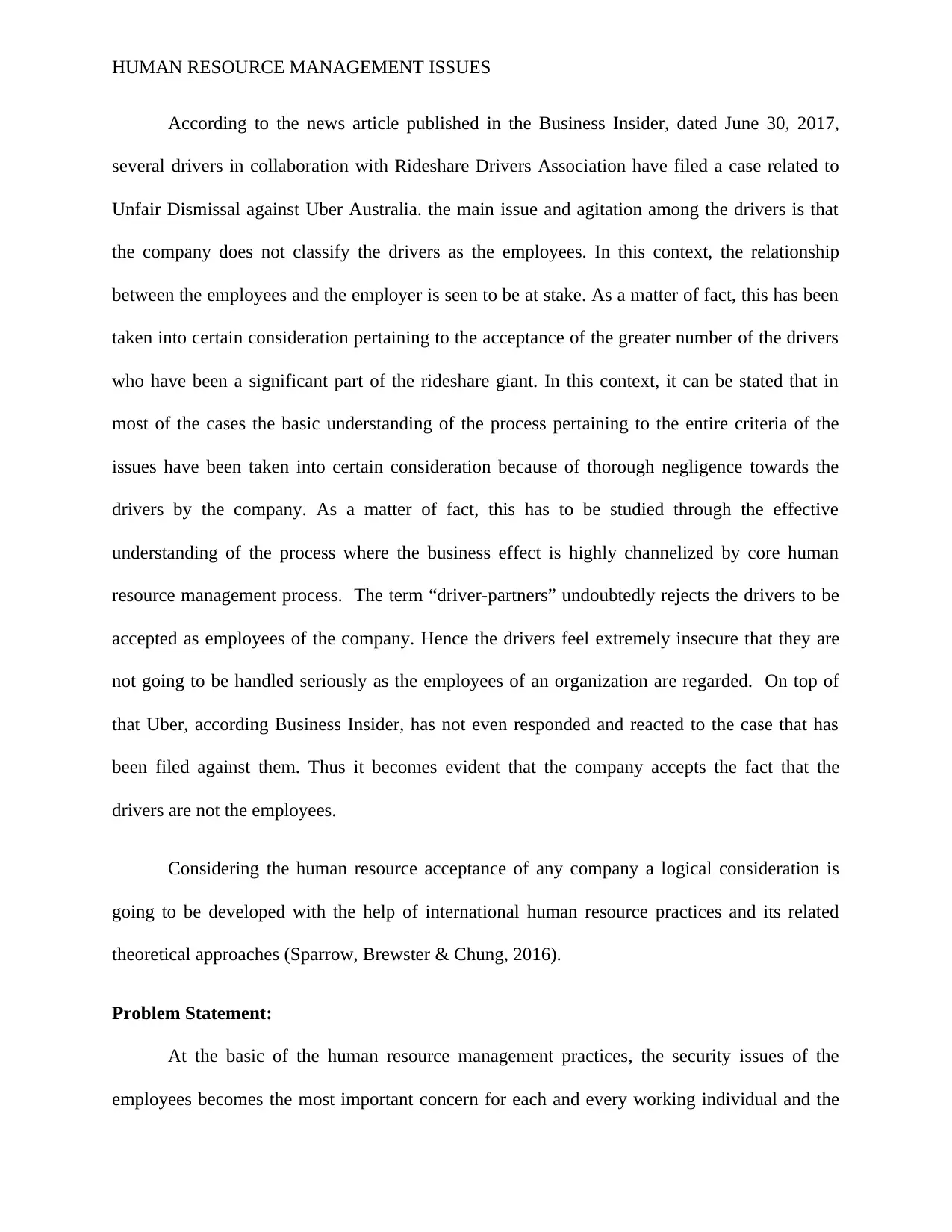
HUMAN RESOURCE MANAGEMENT ISSUES
According to the news article published in the Business Insider, dated June 30, 2017,
several drivers in collaboration with Rideshare Drivers Association have filed a case related to
Unfair Dismissal against Uber Australia. the main issue and agitation among the drivers is that
the company does not classify the drivers as the employees. In this context, the relationship
between the employees and the employer is seen to be at stake. As a matter of fact, this has been
taken into certain consideration pertaining to the acceptance of the greater number of the drivers
who have been a significant part of the rideshare giant. In this context, it can be stated that in
most of the cases the basic understanding of the process pertaining to the entire criteria of the
issues have been taken into certain consideration because of thorough negligence towards the
drivers by the company. As a matter of fact, this has to be studied through the effective
understanding of the process where the business effect is highly channelized by core human
resource management process. The term “driver-partners” undoubtedly rejects the drivers to be
accepted as employees of the company. Hence the drivers feel extremely insecure that they are
not going to be handled seriously as the employees of an organization are regarded. On top of
that Uber, according Business Insider, has not even responded and reacted to the case that has
been filed against them. Thus it becomes evident that the company accepts the fact that the
drivers are not the employees.
Considering the human resource acceptance of any company a logical consideration is
going to be developed with the help of international human resource practices and its related
theoretical approaches (Sparrow, Brewster & Chung, 2016).
Problem Statement:
At the basic of the human resource management practices, the security issues of the
employees becomes the most important concern for each and every working individual and the
According to the news article published in the Business Insider, dated June 30, 2017,
several drivers in collaboration with Rideshare Drivers Association have filed a case related to
Unfair Dismissal against Uber Australia. the main issue and agitation among the drivers is that
the company does not classify the drivers as the employees. In this context, the relationship
between the employees and the employer is seen to be at stake. As a matter of fact, this has been
taken into certain consideration pertaining to the acceptance of the greater number of the drivers
who have been a significant part of the rideshare giant. In this context, it can be stated that in
most of the cases the basic understanding of the process pertaining to the entire criteria of the
issues have been taken into certain consideration because of thorough negligence towards the
drivers by the company. As a matter of fact, this has to be studied through the effective
understanding of the process where the business effect is highly channelized by core human
resource management process. The term “driver-partners” undoubtedly rejects the drivers to be
accepted as employees of the company. Hence the drivers feel extremely insecure that they are
not going to be handled seriously as the employees of an organization are regarded. On top of
that Uber, according Business Insider, has not even responded and reacted to the case that has
been filed against them. Thus it becomes evident that the company accepts the fact that the
drivers are not the employees.
Considering the human resource acceptance of any company a logical consideration is
going to be developed with the help of international human resource practices and its related
theoretical approaches (Sparrow, Brewster & Chung, 2016).
Problem Statement:
At the basic of the human resource management practices, the security issues of the
employees becomes the most important concern for each and every working individual and the
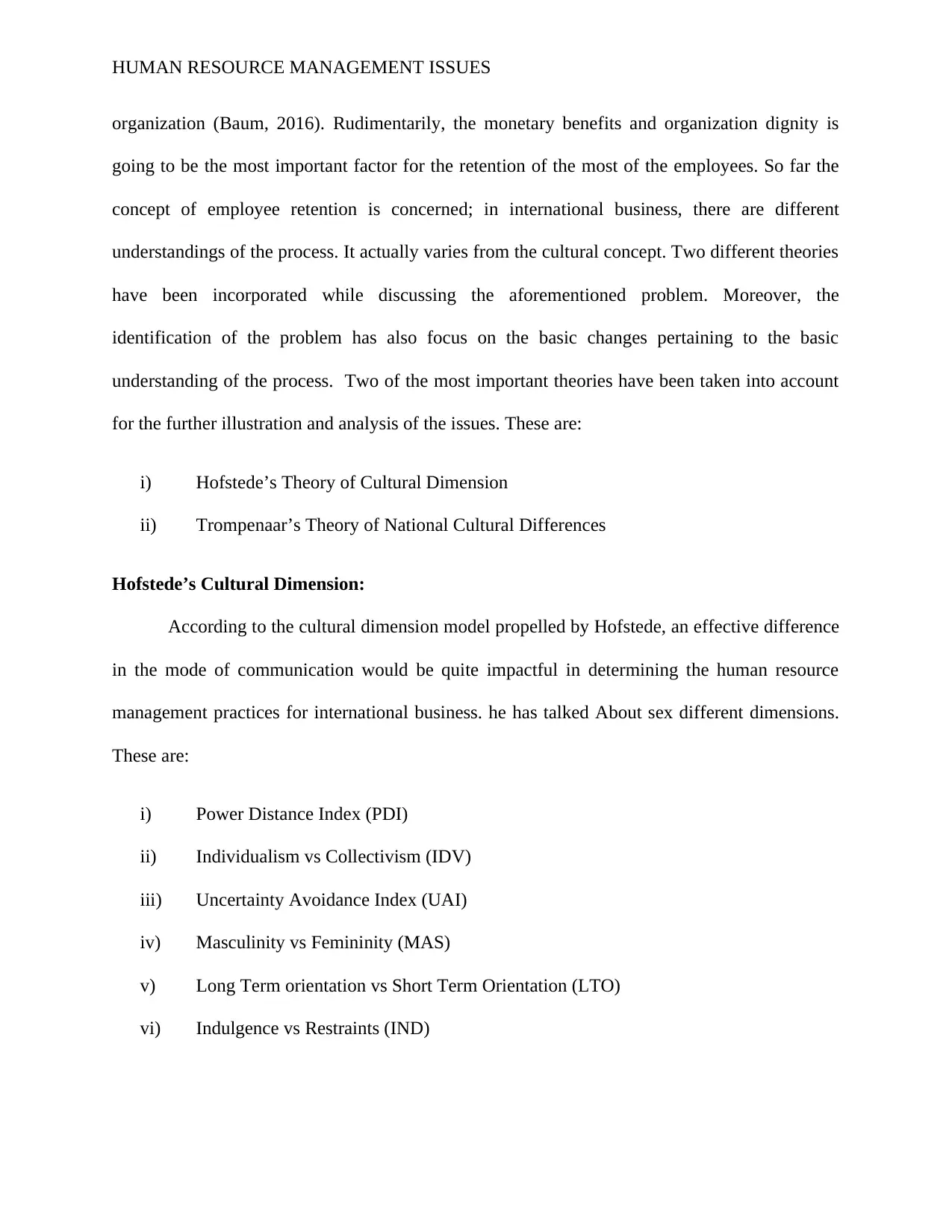
HUMAN RESOURCE MANAGEMENT ISSUES
organization (Baum, 2016). Rudimentarily, the monetary benefits and organization dignity is
going to be the most important factor for the retention of the most of the employees. So far the
concept of employee retention is concerned; in international business, there are different
understandings of the process. It actually varies from the cultural concept. Two different theories
have been incorporated while discussing the aforementioned problem. Moreover, the
identification of the problem has also focus on the basic changes pertaining to the basic
understanding of the process. Two of the most important theories have been taken into account
for the further illustration and analysis of the issues. These are:
i) Hofstede’s Theory of Cultural Dimension
ii) Trompenaar’s Theory of National Cultural Differences
Hofstede’s Cultural Dimension:
According to the cultural dimension model propelled by Hofstede, an effective difference
in the mode of communication would be quite impactful in determining the human resource
management practices for international business. he has talked About sex different dimensions.
These are:
i) Power Distance Index (PDI)
ii) Individualism vs Collectivism (IDV)
iii) Uncertainty Avoidance Index (UAI)
iv) Masculinity vs Femininity (MAS)
v) Long Term orientation vs Short Term Orientation (LTO)
vi) Indulgence vs Restraints (IND)
organization (Baum, 2016). Rudimentarily, the monetary benefits and organization dignity is
going to be the most important factor for the retention of the most of the employees. So far the
concept of employee retention is concerned; in international business, there are different
understandings of the process. It actually varies from the cultural concept. Two different theories
have been incorporated while discussing the aforementioned problem. Moreover, the
identification of the problem has also focus on the basic changes pertaining to the basic
understanding of the process. Two of the most important theories have been taken into account
for the further illustration and analysis of the issues. These are:
i) Hofstede’s Theory of Cultural Dimension
ii) Trompenaar’s Theory of National Cultural Differences
Hofstede’s Cultural Dimension:
According to the cultural dimension model propelled by Hofstede, an effective difference
in the mode of communication would be quite impactful in determining the human resource
management practices for international business. he has talked About sex different dimensions.
These are:
i) Power Distance Index (PDI)
ii) Individualism vs Collectivism (IDV)
iii) Uncertainty Avoidance Index (UAI)
iv) Masculinity vs Femininity (MAS)
v) Long Term orientation vs Short Term Orientation (LTO)
vi) Indulgence vs Restraints (IND)
⊘ This is a preview!⊘
Do you want full access?
Subscribe today to unlock all pages.

Trusted by 1+ million students worldwide
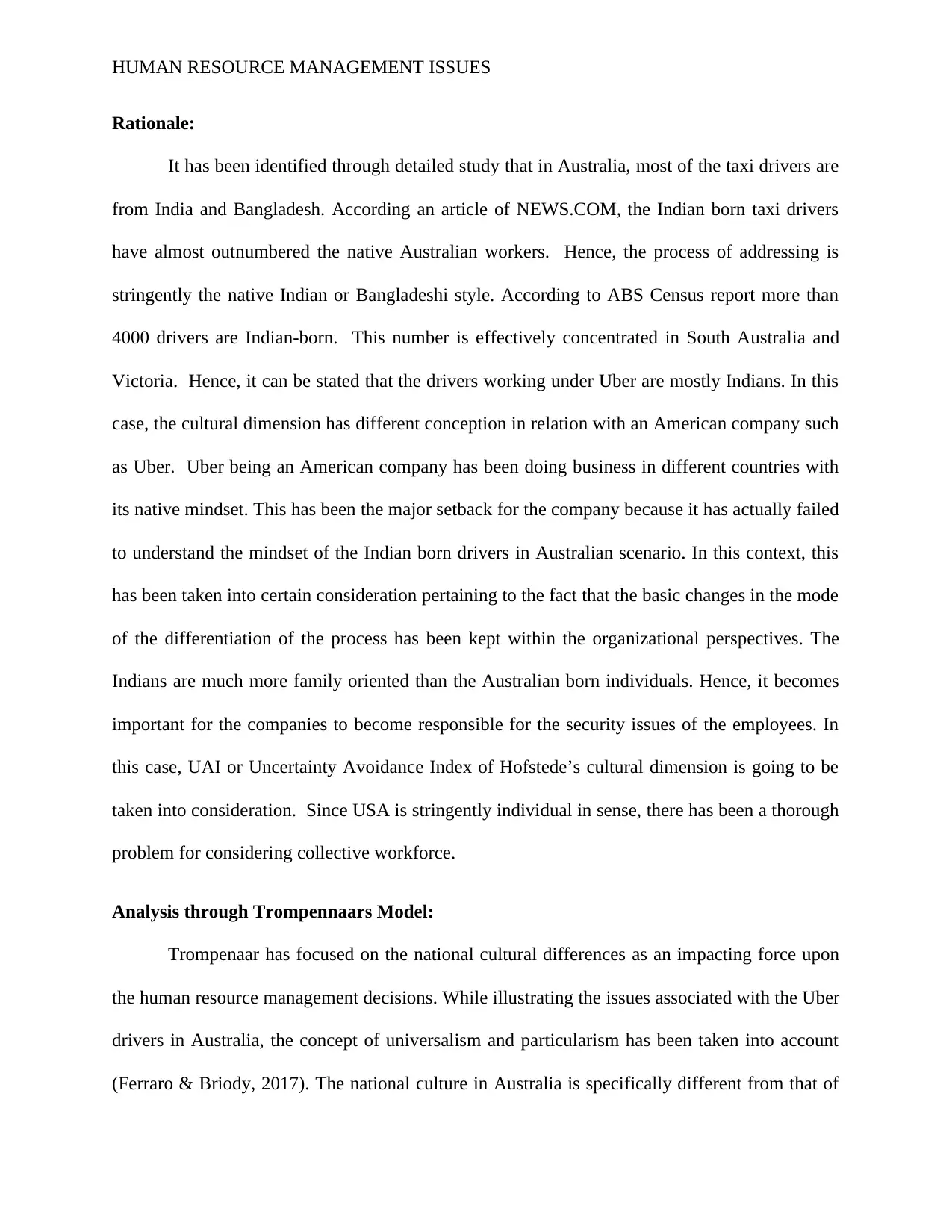
HUMAN RESOURCE MANAGEMENT ISSUES
Rationale:
It has been identified through detailed study that in Australia, most of the taxi drivers are
from India and Bangladesh. According an article of NEWS.COM, the Indian born taxi drivers
have almost outnumbered the native Australian workers. Hence, the process of addressing is
stringently the native Indian or Bangladeshi style. According to ABS Census report more than
4000 drivers are Indian-born. This number is effectively concentrated in South Australia and
Victoria. Hence, it can be stated that the drivers working under Uber are mostly Indians. In this
case, the cultural dimension has different conception in relation with an American company such
as Uber. Uber being an American company has been doing business in different countries with
its native mindset. This has been the major setback for the company because it has actually failed
to understand the mindset of the Indian born drivers in Australian scenario. In this context, this
has been taken into certain consideration pertaining to the fact that the basic changes in the mode
of the differentiation of the process has been kept within the organizational perspectives. The
Indians are much more family oriented than the Australian born individuals. Hence, it becomes
important for the companies to become responsible for the security issues of the employees. In
this case, UAI or Uncertainty Avoidance Index of Hofstede’s cultural dimension is going to be
taken into consideration. Since USA is stringently individual in sense, there has been a thorough
problem for considering collective workforce.
Analysis through Trompennaars Model:
Trompenaar has focused on the national cultural differences as an impacting force upon
the human resource management decisions. While illustrating the issues associated with the Uber
drivers in Australia, the concept of universalism and particularism has been taken into account
(Ferraro & Briody, 2017). The national culture in Australia is specifically different from that of
Rationale:
It has been identified through detailed study that in Australia, most of the taxi drivers are
from India and Bangladesh. According an article of NEWS.COM, the Indian born taxi drivers
have almost outnumbered the native Australian workers. Hence, the process of addressing is
stringently the native Indian or Bangladeshi style. According to ABS Census report more than
4000 drivers are Indian-born. This number is effectively concentrated in South Australia and
Victoria. Hence, it can be stated that the drivers working under Uber are mostly Indians. In this
case, the cultural dimension has different conception in relation with an American company such
as Uber. Uber being an American company has been doing business in different countries with
its native mindset. This has been the major setback for the company because it has actually failed
to understand the mindset of the Indian born drivers in Australian scenario. In this context, this
has been taken into certain consideration pertaining to the fact that the basic changes in the mode
of the differentiation of the process has been kept within the organizational perspectives. The
Indians are much more family oriented than the Australian born individuals. Hence, it becomes
important for the companies to become responsible for the security issues of the employees. In
this case, UAI or Uncertainty Avoidance Index of Hofstede’s cultural dimension is going to be
taken into consideration. Since USA is stringently individual in sense, there has been a thorough
problem for considering collective workforce.
Analysis through Trompennaars Model:
Trompenaar has focused on the national cultural differences as an impacting force upon
the human resource management decisions. While illustrating the issues associated with the Uber
drivers in Australia, the concept of universalism and particularism has been taken into account
(Ferraro & Briody, 2017). The national culture in Australia is specifically different from that of
Paraphrase This Document
Need a fresh take? Get an instant paraphrase of this document with our AI Paraphraser
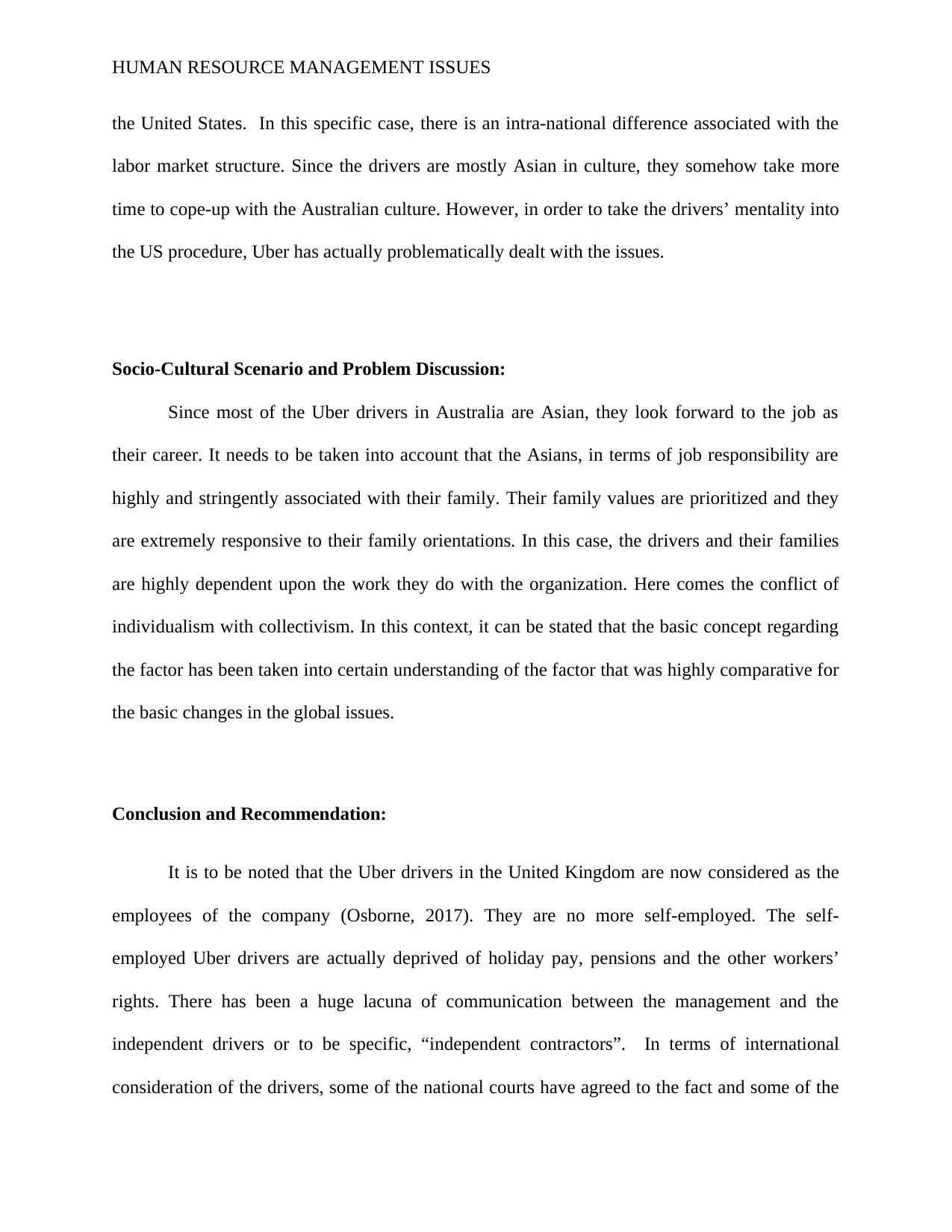
HUMAN RESOURCE MANAGEMENT ISSUES
the United States. In this specific case, there is an intra-national difference associated with the
labor market structure. Since the drivers are mostly Asian in culture, they somehow take more
time to cope-up with the Australian culture. However, in order to take the drivers’ mentality into
the US procedure, Uber has actually problematically dealt with the issues.
Socio-Cultural Scenario and Problem Discussion:
Since most of the Uber drivers in Australia are Asian, they look forward to the job as
their career. It needs to be taken into account that the Asians, in terms of job responsibility are
highly and stringently associated with their family. Their family values are prioritized and they
are extremely responsive to their family orientations. In this case, the drivers and their families
are highly dependent upon the work they do with the organization. Here comes the conflict of
individualism with collectivism. In this context, it can be stated that the basic concept regarding
the factor has been taken into certain understanding of the factor that was highly comparative for
the basic changes in the global issues.
Conclusion and Recommendation:
It is to be noted that the Uber drivers in the United Kingdom are now considered as the
employees of the company (Osborne, 2017). They are no more self-employed. The self-
employed Uber drivers are actually deprived of holiday pay, pensions and the other workers’
rights. There has been a huge lacuna of communication between the management and the
independent drivers or to be specific, “independent contractors”. In terms of international
consideration of the drivers, some of the national courts have agreed to the fact and some of the
the United States. In this specific case, there is an intra-national difference associated with the
labor market structure. Since the drivers are mostly Asian in culture, they somehow take more
time to cope-up with the Australian culture. However, in order to take the drivers’ mentality into
the US procedure, Uber has actually problematically dealt with the issues.
Socio-Cultural Scenario and Problem Discussion:
Since most of the Uber drivers in Australia are Asian, they look forward to the job as
their career. It needs to be taken into account that the Asians, in terms of job responsibility are
highly and stringently associated with their family. Their family values are prioritized and they
are extremely responsive to their family orientations. In this case, the drivers and their families
are highly dependent upon the work they do with the organization. Here comes the conflict of
individualism with collectivism. In this context, it can be stated that the basic concept regarding
the factor has been taken into certain understanding of the factor that was highly comparative for
the basic changes in the global issues.
Conclusion and Recommendation:
It is to be noted that the Uber drivers in the United Kingdom are now considered as the
employees of the company (Osborne, 2017). They are no more self-employed. The self-
employed Uber drivers are actually deprived of holiday pay, pensions and the other workers’
rights. There has been a huge lacuna of communication between the management and the
independent drivers or to be specific, “independent contractors”. In terms of international
consideration of the drivers, some of the national courts have agreed to the fact and some of the
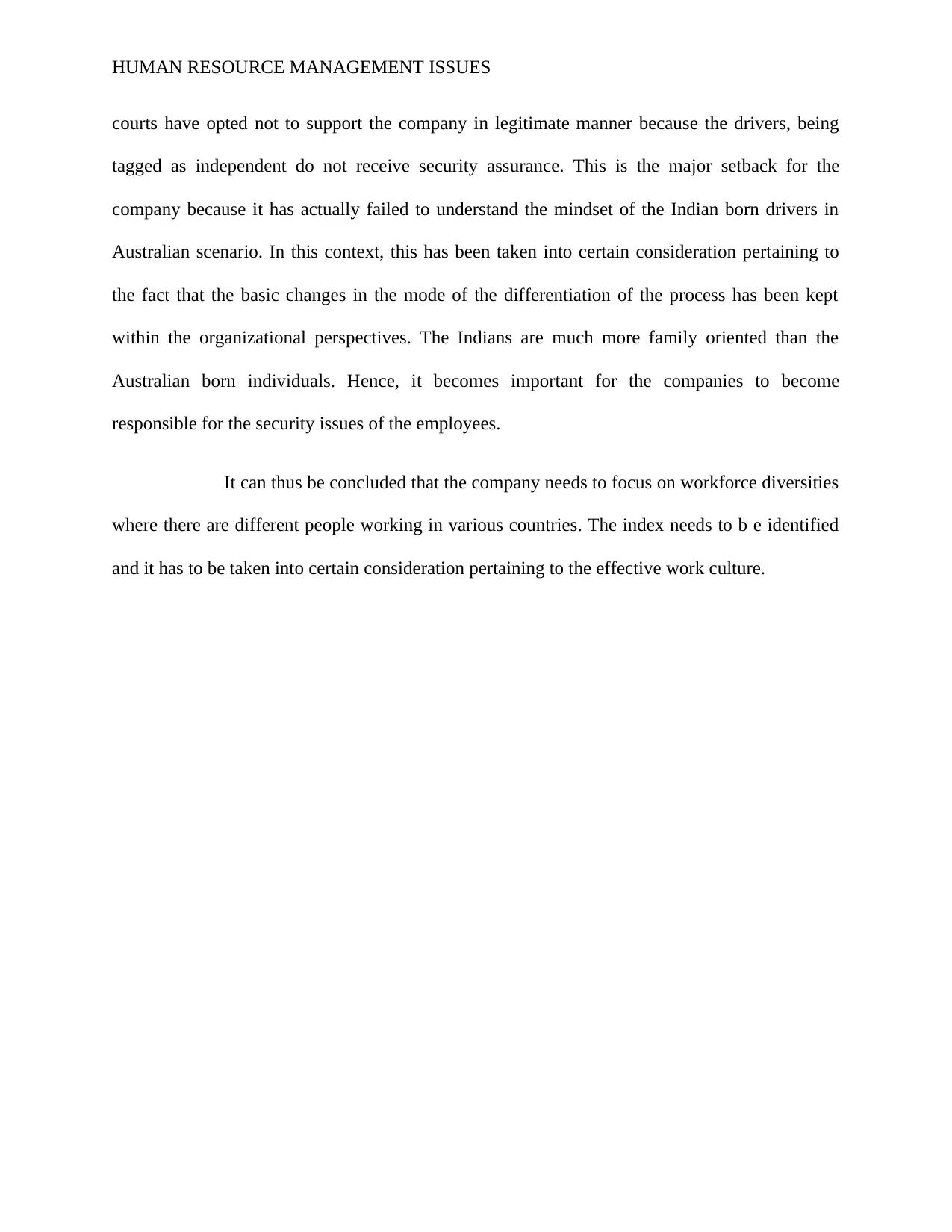
HUMAN RESOURCE MANAGEMENT ISSUES
courts have opted not to support the company in legitimate manner because the drivers, being
tagged as independent do not receive security assurance. This is the major setback for the
company because it has actually failed to understand the mindset of the Indian born drivers in
Australian scenario. In this context, this has been taken into certain consideration pertaining to
the fact that the basic changes in the mode of the differentiation of the process has been kept
within the organizational perspectives. The Indians are much more family oriented than the
Australian born individuals. Hence, it becomes important for the companies to become
responsible for the security issues of the employees.
It can thus be concluded that the company needs to focus on workforce diversities
where there are different people working in various countries. The index needs to b e identified
and it has to be taken into certain consideration pertaining to the effective work culture.
courts have opted not to support the company in legitimate manner because the drivers, being
tagged as independent do not receive security assurance. This is the major setback for the
company because it has actually failed to understand the mindset of the Indian born drivers in
Australian scenario. In this context, this has been taken into certain consideration pertaining to
the fact that the basic changes in the mode of the differentiation of the process has been kept
within the organizational perspectives. The Indians are much more family oriented than the
Australian born individuals. Hence, it becomes important for the companies to become
responsible for the security issues of the employees.
It can thus be concluded that the company needs to focus on workforce diversities
where there are different people working in various countries. The index needs to b e identified
and it has to be taken into certain consideration pertaining to the effective work culture.
⊘ This is a preview!⊘
Do you want full access?
Subscribe today to unlock all pages.

Trusted by 1+ million students worldwide
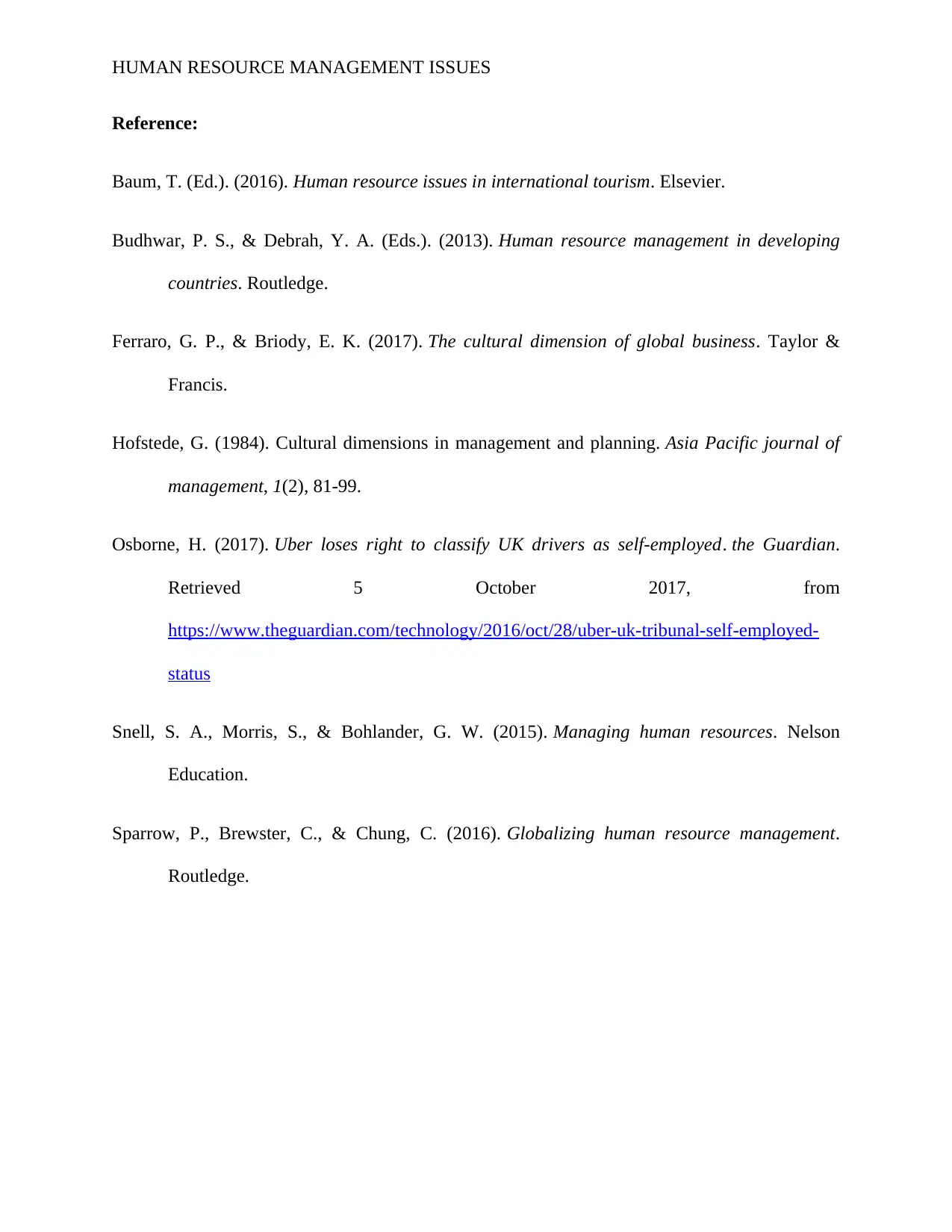
HUMAN RESOURCE MANAGEMENT ISSUES
Reference:
Baum, T. (Ed.). (2016). Human resource issues in international tourism. Elsevier.
Budhwar, P. S., & Debrah, Y. A. (Eds.). (2013). Human resource management in developing
countries. Routledge.
Ferraro, G. P., & Briody, E. K. (2017). The cultural dimension of global business. Taylor &
Francis.
Hofstede, G. (1984). Cultural dimensions in management and planning. Asia Pacific journal of
management, 1(2), 81-99.
Osborne, H. (2017). Uber loses right to classify UK drivers as self-employed. the Guardian.
Retrieved 5 October 2017, from
https://www.theguardian.com/technology/2016/oct/28/uber-uk-tribunal-self-employed-
status
Snell, S. A., Morris, S., & Bohlander, G. W. (2015). Managing human resources. Nelson
Education.
Sparrow, P., Brewster, C., & Chung, C. (2016). Globalizing human resource management.
Routledge.
Reference:
Baum, T. (Ed.). (2016). Human resource issues in international tourism. Elsevier.
Budhwar, P. S., & Debrah, Y. A. (Eds.). (2013). Human resource management in developing
countries. Routledge.
Ferraro, G. P., & Briody, E. K. (2017). The cultural dimension of global business. Taylor &
Francis.
Hofstede, G. (1984). Cultural dimensions in management and planning. Asia Pacific journal of
management, 1(2), 81-99.
Osborne, H. (2017). Uber loses right to classify UK drivers as self-employed. the Guardian.
Retrieved 5 October 2017, from
https://www.theguardian.com/technology/2016/oct/28/uber-uk-tribunal-self-employed-
status
Snell, S. A., Morris, S., & Bohlander, G. W. (2015). Managing human resources. Nelson
Education.
Sparrow, P., Brewster, C., & Chung, C. (2016). Globalizing human resource management.
Routledge.
1 out of 10
Related Documents
Your All-in-One AI-Powered Toolkit for Academic Success.
+13062052269
info@desklib.com
Available 24*7 on WhatsApp / Email
![[object Object]](/_next/static/media/star-bottom.7253800d.svg)
Unlock your academic potential
Copyright © 2020–2025 A2Z Services. All Rights Reserved. Developed and managed by ZUCOL.





